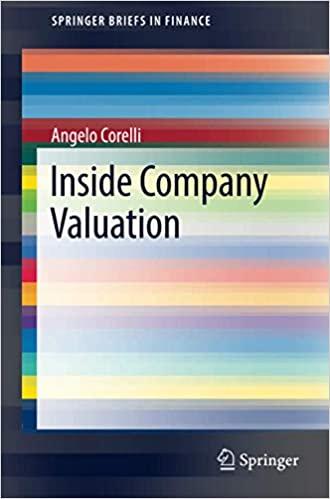Question
Suppose that you have determined that CQ Telecommunications is currently trading at $50 per share, its most recent 12-month earnings amounted to $8.00 per share,
Suppose that you have determined that CQ Telecommunications is currently trading at $50 per share, its most recent 12-month earnings amounted to $8.00 per share, and the cash dividend for the same period was $1.80 per share.
Begin by projecting the future value of one share of stock by using the earnings per share (EPS information). In this case, the price-to-earnings ratio is 6.25 ( $50 price per share$8.00 earnings=6.25 ).
Next, apply an assumed 16.0% rate of growth estimate (the same rate as occurred in previous years, according to the companys annual report) to calculate the earnings per share (EPS) for each year. The following table lists the estimated projections of earnings and dividends for one share of CQ Telecommunications
if you assume a 16.0% rate of growth over the next five years:
End of Year Earnings Dividend Income (Dollars) (Dollars)
Year 1 $9.28 $2.09
Year 2 10.76 2.42
Year 3 12.48 2.81
Year 4 14.48 3.26
Year 5 16.80 3.78
Total dividends: $14.36 Average annual dividend ( 14.365 ): $2.87 Using an assumed price/earnings ratio of 6.25 (the same as the current ratio), you can estimate the market price of the stock after five years to be $ per share. (Note: Round your answer to two decimal places.) Once you have determined the projected stock price and the average annual dividend (as shown in the previous table), you can convert those figures into a potential rate of return by calculating the approximate compound yield (ACY) with the following equation: (Note: Do not round intermediate calculations. Round your final answer to one decimal place.) ACY = Average Annual Dividend+Projected Price of Stock Current Price of StockNumber of Years ProjectedProjected Price of Stock + Current Price of Stock2 = % Step 5 - Compare the Required Rate of Return with the Potential Rate of Return on the Investment After calculating your required rate of return (in step 3) and the potential rate of return on an investment (in step 4), you can compare these two values to determine whether the stock would be a good value for you to buy at the current price. If the potential return on an investment is greater than your required rate of return, the stock may be underpriced, and it might be a good investment at the current price. In the example involving CQ Telecommunications, which value is higher? The required rate of return (from step 3) The stocks potential rate of return (from step 4) Therefore, CQ Telecommunications stock a good investment (that is, an undervalued investment) at the current market price of $50 per share.
Step by Step Solution
There are 3 Steps involved in it
Step: 1

Get Instant Access to Expert-Tailored Solutions
See step-by-step solutions with expert insights and AI powered tools for academic success
Step: 2

Step: 3

Ace Your Homework with AI
Get the answers you need in no time with our AI-driven, step-by-step assistance
Get Started


